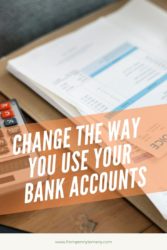Thinking about financially successful people you tend to picture an expensive lifestyle. Living in an enormous villa in an idyllic dream-away place. You would probably need a bank account of a millionaire to be financially successful. Right? Or is there a secret way how to set up your bank accounts for financial success?
While the millionaire’s lifestyle may be a very recognizable way, it actually hasn’t got much to do with financial success. Financial success is more about creating a situation for yourself in which you are happy with the amount of money coming into your bank account given the things you want to own or experience in your life. For one person this perhaps means buying an expensive villa on remote islands in the South Pacific, but for another, the aim is to live close to grandchildren and being able to visit the Zoo with them now and then.
 What is financial success?
What is financial success?
The interpretation of financial success is far more subjective than meets the eye. In general, you could say that being financially successful is best defined as being able to pay for things you want or need in life.
Since everyone’s needs are different, the amount of money needed may vary. But not having to worry about money is one of the main benefits of being financially successful.
Becoming financially successful depends heavily on the decisions you make early in your life. These decisions are essential and will determine whether you can start to reach success as it comes to your finances. I have experienced this myself. It was during the early student years that I learned one of the biggest lessons in financial success.
This insight changed the way I looked at my personal finances and it profoundly changed the way I use my bank accounts today.
How it all began
As I started my new life as a first-year student, I also started taking care of my personal finances. Until then, my parents had always done the finances at home and I only had a checking and a savings account.
When living with my parents, I received a monthly allowance from them and some extra income from my small part-time job. This money was deposited into my account each month.
I used my checking account mainly to buy clothes and to pay for nights out with friends. Only occasionally I was able to save some money in my savings account.
A problematic set-up of my bank accounts
Since the financial set-up did not give me any problems, I didn’t change anything about it when I started living on my own.
Big mistake, because my situation did change! All of the sudden, I had monthly recurring costs that were going out of my bank account. Rent for my room, a phone bill, health insurance, the membership of my student association, and so on. And even though the allowance I received from my parents was raised so I could pay for everything, I soon started to get financial issues.
lack of financial control
One of the main reasons was the lack of insight into the bills that came in. I could just have bought a new pair of shoes when suddenly the rent was due. On top of that, there were also yearly bills; such as the municipality taxes or the settlement of the utility costs. These extra bills made things worse.
I started to lag with my rent and received letters from debt collection agencies that charged high fees, which worsened the problem even further. When I was thousands of euros in debt, I had to take a personal loan to pay the bills, which again added to the costs per month.
Stopping the downward spiral
I clearly ended up in a downward spiral that would not stop until I changed something about my situation. It was then, that I made a profound change in the way I set up my bank accounts. I have used this set-up ever since and I have never again had any financial problems.
As mentioned, the original set-up was pretty straightforward. One bank account on which all income comes in and all expenses are paid from. It proved to be a recipe for disaster because fixed costs and variable costs both had to be paid from the same account, which made it difficult to keep track. So, how to set up your bank accounts for financial success.
The solution is therefore to use not one but two checking accounts. One for your fixed costs and one for all other expenses, such as clothing, eating and drinking, presents and going out. Yes, it sounds simple, but be aware: the simplest solutions are often the best! Making small changes may lead to giant transformations later on. Follow the step-by-step approach in setting up your bank accounts and you will create the perfect circumstances for financial success.
 STRUCTURING your bank accounts
STRUCTURING your bank accounts
- Open two different checking accounts
- Open two different savings accounts
- Calculate the fixed monthly costs you have. Do not leave anything out. Include the yearly bills that will come in and add an extra 10% to the calculated costs for unforeseen costs
- Determine how much money you want to save each month for the short-term (this is for incidental costs, such as a weekend get-away or a new washing machine) and for the long-term (this is for big life goals, for instance, a second house or a trip around the world)
USING THE BANK ACCOUNTS
- Make sure your salary or passive income arrives on one of the two checking accounts
- Each month transfer the amount needed to pay for your fixed monthly costs to your other checking account. Do this as soon as your income arrives. Recalculate the amount needed at least once a year to make sure you still have it right
- Transfer the determined monthly amount to save for incidental short-term expenses to one savings account. Transfer the determined monthly amount to save for long-term expenses to the other savings account. Do this as soon as your income arrives as well
- Make sure you pay all fixed costs from the second account. If possible use automatic collection, so the bills will be paid automatically and you do not have to worry about missing a payment.
- Finally, use the money left on your first checking account to pay for your variable costs during the month. If you like the challenge, see if you can use a weekly budget to minimize your expenditure.
If you are having trouble structuring your bank accounts, you might want to look at your spending and your income. By categorizing all your costs, you can determine what your fixed costs are.
Did you know?
In the Financial Freedom Toolkit we provide you with a lot more information about how to set up your bank accounts for financial success. An extensive bank account structure for your savings and investments is in the Toolkit as well. With this structure, we were able to save for a house! For ONLY $69 you get a head-start in your Financial Freedom journey! So, transform ‘one day’ into ‘day one’ and start with the Design Your Financial Freedom Toolkit today!


 What is financial success?
What is financial success? STRUCTURING your bank accounts
STRUCTURING your bank accounts


